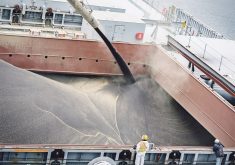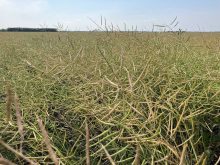Canola growers have become comfortable with high prices and good margins, but analysts say the crop’s two crucial elements are both flashing warnings.
Canola and U.S. soybean prices shot higher last summer when the U.S. Midwest drought bit in. They have since subsided but could drop significantly further if the Midwest drought ends and vegetable oil value once more determines the price for canola.
“Some caution is merited,” technical analyst Harold Davis of Prairie Crop Charts said in a recent analysis of the divergence of canola values from their traditional marriage to soybean oil prices.
Read Also

Grain farming’s hard times expected to continue
Rabobank says it will be two more years before North American grain farmers achieve break-even due to “monster” supplies and “sticky” crop input prices.
“Since March 2012, the relative price difference between canola and soybean oil has been driven by canola’s meal value, so the spread is not out of line, but it would be nice to see bean oil show some life.”
Soybean oil futures have been weak for more than a year as the world became glutted with palm oil, which is the world’s baseline vegetable oil. Canola traditionally tracks movements in soy oil much more closely than it does soybeans because 80 percent of canola’s overall value is usually in the oil, while soybeans get most of their value from the meal.
Oil makes up 45 percent of the weight of canola seed, while it is only 20 percent in soybeans. Oil is also a much more highly valued product than meal, which makes canola an overwhelmingly oil-priced crop.
However, the U.S. Midwest drought robbed American livestock feeders of both of their traditional feed sources: corn and soybean meal.
That increased meal prices and also drove up prices for soybeans and canola.
Chuck Penner of LeftField Commodity Research said the Midwest drought significantly affected the soybean crush component spread.
Soybeans generally found 45 percent of their value in oil in 2010 and 2011, but that fell to 33 percent as the meal component soared during the drought. It has recently returned to 38 percent.
Recent falling meal prices didn’t affect canola as much as they did soybeans because meal makes up a much smaller proportion of the weight of canola seeds.
It’s why canola prices only partially followed the incredible soybean rally of last summer, although the increase in meal value was so great that canola prices still increased by dollars per bushel.
Penner said oil prices are becoming relatively greater within the spread in recent weeks, but not because the oil is becoming more expensive. Meal prices have been falling, so the spread might come back together for a reason that most canola growers wouldn’t like.
The weakness in vegetable oil prices worries Errol Anderson of ProMarket Communications.
Anderson said most farmers don’t realize that today’s canola prices are based on a short-term weather event and that the underlying value of the crop is weak.
“This was a bubble market,” he said.
“I don’t think the growers understand that. They’ve been led to believe canola has its own life.”
The spurt of crusher expansions and new plants has created solid ongoing prairie demand for canola, but that doesn’t mean prices are safe, Anderson said. Prices will have to fall to meet international demand if the drought premium wears off in North America.
“For the offshore market, we’re too high,” said Anderson.
Analysts say crushers and the world market are hungry for oil and meal.
However, a large supply of oil in the world market and an expected disappearance of the North American drought means farmers might have to accept lower prices to generate demand.















